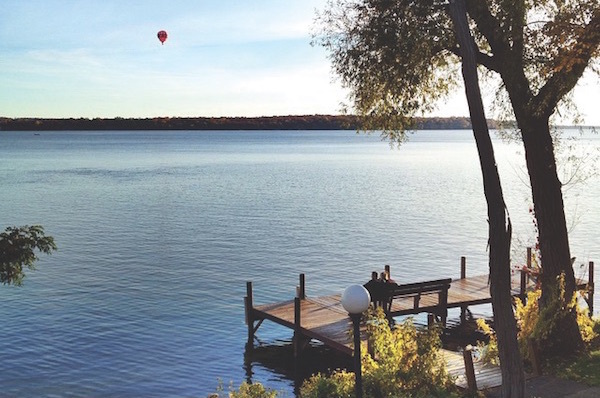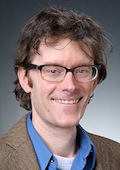Researchers study Wisconsin’s deepest natural lake to help preserve ‘an ecological jewel’

Three UW–Madison faculty members specializing in agriculture and water quality are leading an interdisciplinary analysis of Green Lake and its watershed to better understand what’s happening — and to find some possible solutions.
Photo: Corey Taratuta
UW-Madison researchers have teamed up with community leaders to analyze Green Lake, Wisconsin’s deepest natural inland lake and a crucial habitat for lake trout and other cold water species.
In 2014, the Wisconsin Department of Natural Resources designated the lake as “impaired” because it failed to meet water quality standards due to low levels of dissolved oxygen at certain depths, which can happen when increasing amounts of phosphorus, sediment and algae alter the lake’s ecology. When oxygen levels fall below a certain point, many native species die out.

Kucharik

Thompson

Vander Zanden
This summer, three faculty members specializing in agriculture and water quality are leading an interdisciplinary analysis of the lake and its watershed to better understand what’s happening — and to find some possible solutions.
Chris Kucharik, a professor of agronomy and environmental studies and an affiliate of the Nelson Institute Center for Sustainability and the Global Environment, is working with Anita Thompson, a professor of biological systems engineering and incoming chair of the Nelson Institute’s Water Resources Management program, and Jake Vander Zanden, a professor of zoology with the UW Center for Limnology, to develop information and models that will support the management plan and help restore Green Lake.
Additionally, two Nelson Institute graduate student project assistants, Annie Lord and Sarah Fuller, are reviewing the many studies that have already been done on different aspects of the lake to investigate the physical and natural makeup of the watershed and compile social science data from personal interviews and surveys.

John Nelson
“It was an ecological jewel,” says John Nelson, an emeritus member of the Nelson Institute Board of Visitors and UW–Madison adjunct professor of civil and environmental engineering, who spent his childhood summers swimming, snorkeling, skiing and paddling in Green Lake’s crystal-clear waters. “You could drop a net along the pier and catch enough minnows to fill a bucket. You could take them in the rowboat and fish the 60-foot drop-off in front of our house — which you could see because the lake was so clear. You could catch dinner and row back in, all within an hour.”
But those pristine conditions are long gone, as Green Lake faces challenges common to waters in agricultural and developing landscapes. Dairy farms produce a significant amount of manure, a natural fertilizer containing critical nutrients such as phosphorus that farmers spread on their fields. During heavy rains, fields can erode and wash phosphorus into streams that feed into the lake, providing a nutrient overload that fuels excess plant and algae growth and degrades water quality.
“If you think of south-central to east-central Wisconsin, that’s our most concentrated area of agriculture in the state,” says Kucharik.
In 2011, the Green Lake Sanitary District (GLSD), in collaboration with the Green Lake Association, the Green Lake Conservancy, Green Lake and Fond du Lac counties, the Wisconsin Department of Natural Resources and other partners, developed a new, comprehensive lake management plan.
“Our goal is to use the Nelson Institute’s involvement as a catalyst that creates a model for watershed management. ”
Stephanie Prellwitz
“Phosphorus reduction is a very big challenge for our lake, but we’re making significant strides,” says GLSD administrator Charlie Marks. “I believe we will continue to see incremental improvements in this area if we can continue with our current strategies and solutions. I believe this is a winnable battle.”
Stephanie Prellwitz, the executive director of the Green Lake Association and a UW–Madison alumna who studied under Thompson, says the university can help the coalition identify broad lessons that can be applied to other communities facing similar water quality issues.
“Our goal is to use the Nelson Institute’s involvement as a catalyst that creates a model for watershed management,” says Prellwitz. “We want to improve water quality on Green Lake in a way that creates a framework to tackle these issues and validate solutions.”
For his part, Nelson says he recognizes that Green Lake will probably never return to its pristine historical conditions. Still, he’d like to see a reversal of the trend toward degradation.
“I know there’s no going back, but what I inherited should be available in some similar form to people for generations to come,” he says.
Subscribe to Wisconsin Ideas
Want more stories of the Wisconsin Idea in action? Sign-up for our monthly e-newsletter highlighting how Badgers are taking their education and research beyond the boundaries of the classroom to improve lives.
Tags: environment, pollution, The Wisconsin Idea, water




